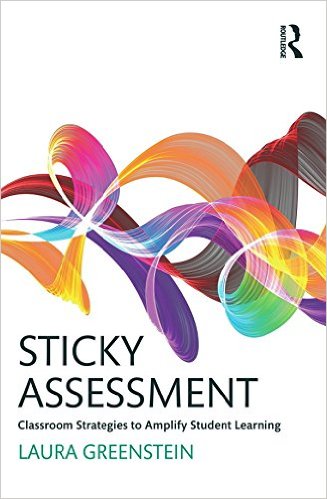STICKY ASSESSMENT Classroom Strategies to Amplify Student Learning

“Sticky Assessment is a straightforward guide to assessment that helps teachers monitor learning, make assessment engaging and meaningful for students, and improve rather than simply measure learning outcomes.”
“With a multitude of engaging and realistic classroom examples, Greenstein uses contemporary research extensively to show how teachers can plan and implement effective assessment. Her emphasis on the integration of assessment with teaching throughout the text illustrates in practical language how teachers can use assessment to enhance student learning and motivation. Her engaging, non-technical writing style concisely captures all critical components of the assessment process.” James H. McMillan, Professor, Virginia Commonwealth University
QUOTES FROM THE BOOK
“Rather than an add-on, assessment is an essential and ingrained element of reciprocal teaching and learning.” p. 6
“The process of on-going active retrieval corresponds with these basic tenets of quality assessment: clear criteria, alignment with learning outcomes, routine check-ins, engaged learners, and purposeful responses.” p. 63
“Giving students multiple and diverse opportunities to show what they know results in the widest and most inclusive displays of their knowledge and skills.” p. 77
“Assessments that are sticky work in two ways. They catch a student’s attention, serving as the glue of learning. They also reveal how well the learning is sticking and how deeply the student is learning.” p.90
“With choice comes accountability. When students set the learning targets and formulate their own learning plans they are developing a sense of ownership and responsibility for their achievement.” p. 101
“What makes embedded assessment different is that students do not notice they are being assessed.” p. 118
“With deeper learning, students become investigators and producers. This requires multidimensional assessment of hypothesizing, predicting, planning, constructing, and displaying.” p. 126
“Despite all our efforts to make assessment an exact science there still remains a significant element of professional judgment.” p. 135
“An alternative to external control is the development of local balanced assessment systems that are comprehensive, purposeful, formative, and responsive.” p. 152
- Available from Routledge/Eye on Education and Amazon ISBN-13: 978-1138640917
- You can find more information on assessment at the Assessment Network: www.assessmentnetwork.net
- Contact the author at lauragteacher1@gmail.com